We ask you, humbly: don't scroll away.
Hi readers, it seems you use Catholic Online a lot; that's great! It's a little awkward to ask, but we need your help. If you have already donated, we sincerely thank you. We're not salespeople, but we depend on donations averaging $14.76 and fewer than 1% of readers give. If you donate just $5.00, the price of your coffee, Catholic Online School could keep thriving. Thank you.Help Now >
Corrosion On 50 Year Old Anchor Tendons A Threat to Oroville Dam Spillway? Over Half Radial Spillway Gates Damaged & CEII Secret Because of This?
FREE Catholic Classes
CA Division of Safety of Dams 2016 Inspection report reveals that critical structural support post-tensioned steel rods in the concrete pillars at the Radial Trunnion Gates of the Spillway were tested, due to their nearing their end of a 50 year life. Although the 2016 corrosion test results deemed "satisfactory", a March 22 DWR Project Safety Compliance Report now places doubt on up to 240 critical support steel rods from DWR's report - "Completion of Follow-Up Radial Gate Structural Inspection, Gates Nos. 3, 4, 5, 6, & 7". Why now? Why CEII 'Secret' status?
 Hi readers, it seems you use Catholic Online a lot; that's great! It's a little awkward to ask, but we need your help. If you have already donated, we sincerely thank you. We're not salespeople, but we depend on donations averaging $14.76 and fewer than 1% of readers give. If you donate just $5.00, the price of your coffee, Catholic Online School could keep thriving. Thank you. Help Now >
Hi readers, it seems you use Catholic Online a lot; that's great! It's a little awkward to ask, but we need your help. If you have already donated, we sincerely thank you. We're not salespeople, but we depend on donations averaging $14.76 and fewer than 1% of readers give. If you donate just $5.00, the price of your coffee, Catholic Online School could keep thriving. Thank you. Help Now >
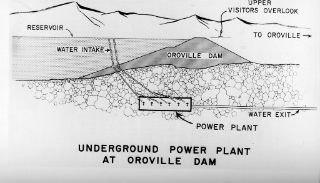
Highlights
LOS ANGELES, CA (California Network) - A significant and new issue of aging 50 year old post-tensioned steel "anchor tendon" rods, in the Radial Trunnion Spillway gate concrete columns, may be unfolding. So serious are the critical structural dependencies on these reinforcing spillway "anchor tendons" that any indication of a weakening places concerns to what degree may the load rating of the columns have been compromised. Indeed, many bridge collapses have occurred precisely from corrosion defects in older designs incorporating highly tensioned reinforcing "tendons" that have led to replacing and even eliminating, by redesign, the risk from using these sudden explosive steel rupturing failure mode "tendons". In 2002, a 120-MW Alvkarleby hydro project dam north of Stockholm Sweden found that a number of anchors had ruptured within their concrete stabilized post-tension anchors in the intake canal [1]. With the crippled state of the Oroville Spillway, the latest news of a new Radial Gate potential issue, that possibly degrades the operational safety limits of 5 out of 8 of the Radial Trunnion Gates, is very troubling.
In the midst of the current spillway crisis, the public should be informed through transparency of information. Seeking a Critical Energy Infrastructure Information (CEII) status [4], resulting in "Secret" for all new spillway reports [2], if done for a Structural Integrity issue on the Anchor Tendons surely rises to the level of importance for revelation to the public. As these "anchor tendons" are imbedded within the concrete column, seeking a CEII, would seem counter to the FERC website usage of an information security risk [4]. Yet, DWR's spokeswoman Lauren Bisnett has cited federal dam-security regulations in declining interview requests by The Sacramento Bee [3].
Anchor Tendons in the main spillway gate structure are used to strengthen the concrete using "tension bars". These end-threaded steel bars are anchored in the concrete at one end, tightened using a nut and bearing plates at the other end, and then grouted in the sleeve within the concrete. This technique is called Bonded post-tensioning. Oroville Spillway Anchor Tendons are rated at 160,000 psi (tensile) strength. With 48 anchor tendons per radial spillway gate, the combined structural re-inforcing dependency is significant to safe operation design ratings. If DWR feels that this requires a CEII status, even though the tendons are imbedded within the concrete, to what degree is the degradation risk? To what degree has the strength of the design been reduced? Is there a safety margin at 100,000 cfs? Is there a safety margin at 50,000 cfs? What is the safety margin? Or is this "unknown at this time"? Why keep such critical information from the public - when security is not an issue in protecting anchor tendon access?
So why now? Why has DWR possibly generated a swift report response as the "Follow-Up" to the initial 2016 Safety Inspection where three hundred and eighty four individual tests would have to have been performed (in a sophisticated Time Domain Reflectometry mechanical type of 3D analysis of all of the steel anchor tendon rods, data analyzed, calculations performed, and then reports generated) just in time for filing 2 days before the next BOC report was to be released? Was DWR asked by FERC or the BOC independent experts to complete their analysis in the 2016 promised "Follow-Up"? If so, the optics infer expeditious actions to get this done "just in time" and then filing a Project Safety Compliance Report in seeking "Secret" CEII status.
Note: Original Images marked up in red to highlight, circle, and denote points of interest.
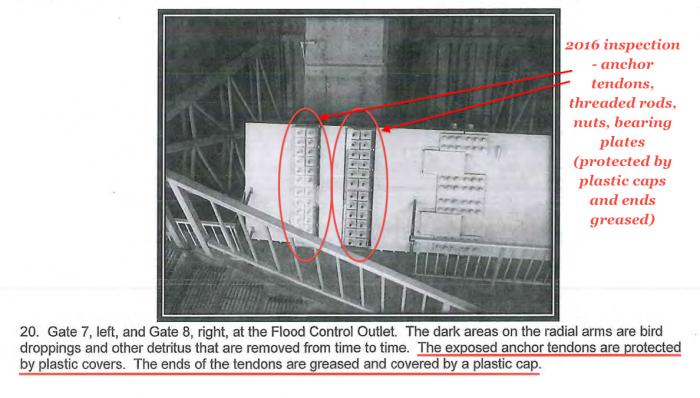
Fig 1. Image of end bolts, nuts, plates (circled) of 50 year old post-tensioned steel rods (anchor tendons) from 2016 Safety Inspection. Anchor Tendons rated to 160,000 psi (tensile) max. Tendons imbedded and anchored within the concrete column to ensure the integrity of Trunnion forces from hydrostatic & hydrodynamic water forces during spillway sealing and operation. Failures in bridges and dams have occurred from internal corrosion of these "anchor tendon" designs. Grease and Plastic caps/covers used at Oroville Spillway anchor tendons to help mitigate corrosion damage.
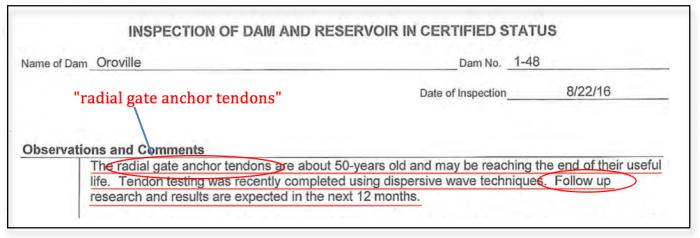
Fig 2. 2016 CA Division of Safety of Dams report. All of the Main Spillway's 340 anchor tendons were tested using a "dispersive wave technique" to detect minor to gross corrosion defects internal to the anchor tendons. Report deemed results "satisfactory". Included was the statement of an "expected" "Follow up" of further "research and results". The DWR March 22 filed report states "Completion of Follow-Up" noting "Radial Gate Structural Inspection". The 2016 Inspection report noted that this was the only Radial Gate item that was to have a "Follow Up".
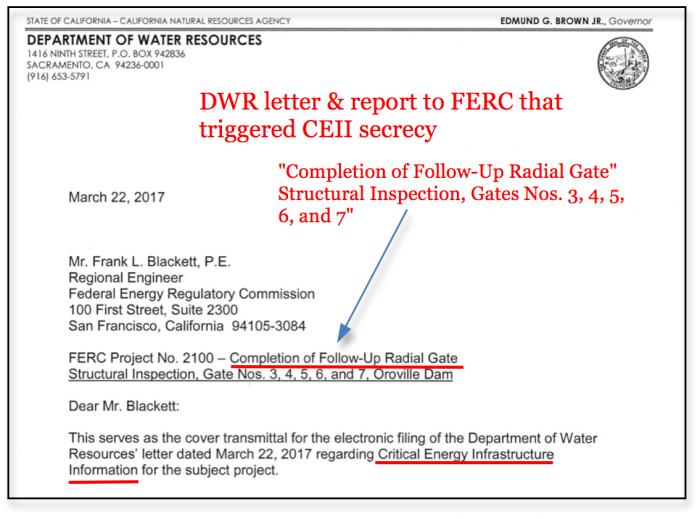
Fig 3. March 22 DWR Report, on "Completion of Follow-Up" noting "Radial Gate Structural Inspection", where the cover letter reveals the request for CEII secrecy status.
More Reading:
[1] "Dam Safety: Investigating Failures of Post-Tensioned Anchors" Hydroworld.com http://www.hydroworld.com/articles/print/volume-17/issue-4/articles/dam-safety-investigating-failures-of-post-tensioned-anchors.html
[2] "Are Oroville Dam Spillway Reports now "secret" due to CA Department of Water Resources requesting CEII status?" Catholic Online www.catholic.org/news/green/story.php?id=74343
[3] "Oroville Dam documents kept secret by state, federal officials" The Sacramento Bee http://www.sacbee.com/news/state/california/water-and-drought/article141963119.html#storylink=cpy
[4] "Critical Energy/Electric Infrastructure Information (CEII)" - " a document can be made confidential if it "gives strategic information" related to "the production, generation, transmission, or distribution of energy" or could be "useful to a person planning an attack on critical infrastructure."""FERC CEII website " https://www.ferc.gov/legal/ceii-foia/ceii.asp
---'Help Give every Student and Teacher FREE resources for a world-class Moral Catholic Education'
Copyright 2021 - Distributed by Catholic Online






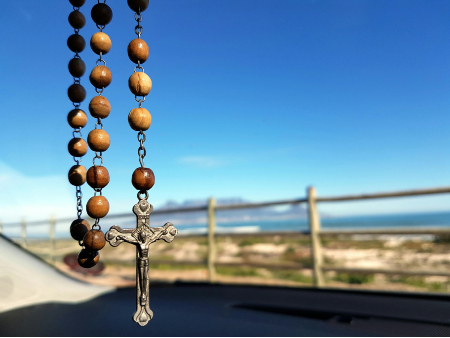


 Daily Readings for Wednesday, April 17, 2024
Daily Readings for Wednesday, April 17, 2024 St. Anicetus: Saint of the Day for Wednesday, April 17, 2024
St. Anicetus: Saint of the Day for Wednesday, April 17, 2024 Prayer to Love God above all Things: Prayer of the Day for Wednesday, April 17, 2024
Prayer to Love God above all Things: Prayer of the Day for Wednesday, April 17, 2024


